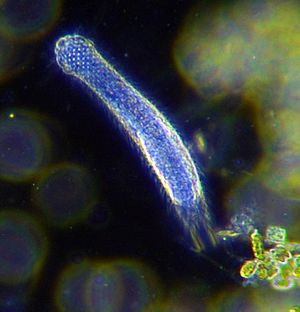Eutely facts for kids

Eutelic organisms are living things that have a fixed number of somatic cells (body cells) when they become adults. This exact number is always the same for every member of a specific species. These organisms grow by cell division (cells splitting) only until they reach maturity. After that, they grow bigger only by their existing cells getting larger, not by making new ones.
Most eutelic organisms are very small, often microscopic. Some examples include nematodes (like ascaris), gastrotrichs, rotifers, tardigrades (also known as water bears), and dicyemida.
Contents
What Does Eutelic Mean?
The word "eutelic" comes from Greek words. "Eu-" means "good" or "true," and "telos" means "end" or "completion." So, it means reaching a "true end" in terms of cell number.
How Eutelic Organisms Grow
Imagine a tiny animal that starts with just a few cells. As it grows, these cells divide and make more cells. This process continues until the animal reaches its adult size. At this point, it stops making new cells. From then on, if the animal gets bigger, it's because its existing cells are growing in size. They don't add any new cells to their body.
This is different from how humans and many other animals grow. We keep making new cells throughout our lives, even as adults. For example, our skin cells are constantly replaced.
Why Have a Fixed Cell Number?
Scientists believe that having a fixed number of cells might be helpful for very small organisms. It could make their development process simpler and more precise. It might also help them grow quickly to their adult size.
Examples of Eutelic Animals
Many tiny creatures are eutelic. Let's look at a few:
Nematodes
Nematodes are also called roundworms. They are found almost everywhere on Earth, from soil to water, and even inside other animals. Many nematodes are eutelic. For example, the well-studied worm Caenorhabditis elegans (often called C. elegans) is a classic example. It has exactly 959 somatic cells in its adult body. Scientists have studied this worm a lot to understand how cells develop.
Rotifers
Rotifers are tiny animals that live in fresh water. They are known for a special ring of cilia (tiny hair-like structures) around their mouth, which they use to swim and gather food. Most rotifers are eutelic. They have a specific number of cells that doesn't change once they are adults.
Tardigrades
Tardigrades, or water bears, are famous for being incredibly tough. They can survive extreme conditions like freezing cold, intense heat, and even the vacuum of space! These amazing creatures are also eutelic. They reach their adult size with a set number of cells, and then their cells just get bigger if they need to grow more.
Gastrotrichs
Gastrotrichs are another group of tiny, worm-like animals that live in water. They have bristles on their bodies and move by gliding. Like the others, gastrotrichs are eutelic, meaning their cell count is fixed once they mature.
See also
 In Spanish: Eutelia para niños
In Spanish: Eutelia para niños

